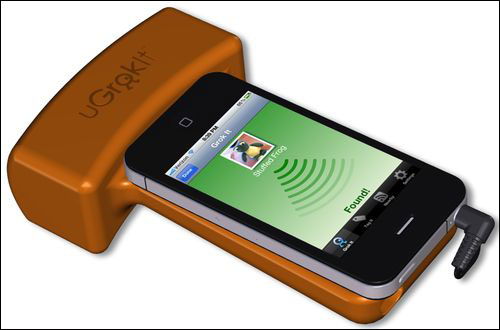An idea for an inexpensive passive RFID device that could track household belongings got its start while two parents were searching for their children’s missing gloves. Those parents, Carrie and Tony Requist, have since founded a company that employs an ultrahigh-frequency (UHF) EPC Gen 2 RFID reading device plugged into a smartphone to locate items to which inexpensive adhesive RFID tags have been attached. And although the startup—known as U Grok It—focuses on solving household organization problems for busy mothers and other individuals, the solution is intended for a much larger audience, says Carrie Requist, the company’s CEO (her husband is the CTO). Once the system becomes commercially available, she expects that the technology could be utilized by small businesses to manage inventory or assets inexpensively.
Both founders have backgrounds in technology and business startups. Before designing their solution, the couple looked into existing RFID-based tracking systems, such as those offered by Treehouse Labs or Loc8tor (see Treehouse Labs Unveils iPhone RFID System for Locating People and Things and Loc8tor Homes In on RFID App for Consumers). In the course of their research, Requist says, they learned that most RFID-based tracking systems on the market were based on active RFID technology, requiring battery-powered tags, and were thus fairly expensive. A kit consisting of a handheld reader, active tags and software could cost hundreds of dollars, she says, depending on the quantity of tags purchased. A starter kit (a reader and two battery-powered tags) for Treehouse Lab’s Bikn system costs $120, with a pair of additional tags costing $49, while Loc8tor’s Plus pack costs $170 for a handheld reader and four battery-powered tags, with each pair of additional tags costing $45. There were also passive-tag solutions on the market using Near Field Communication (NFC) RFID technology, such as those offered by Sony Ericsson, Wireless Dynamics or Alcatel-Lucent (see RFID News Roundup: Sony Ericsson Announces NFC-enabled Xperia Smartphones, Tags, RFID News Roundup: Wireless Dynamics Debuts RFID Reader-Writer for iPhones and Alcatel-Lucent Launching Consumer RFID Product), but NFC systems have a very short read range—typically, only a few centimeters. Microelectronics Technology offers an RFID ME interrogator that can be used to identify items by means of UHF Gen 2 passive tags, but the device comes in the form of a dongle that plugs into the USB port of a computer or a tablet (see Home-Shopping Theme Park to Employ RFID).
Instead, the Requists developed a UHF EPC Gen 2 reader that can be attached to the audio port of a smartphone using the Android or Apple operating system. A user would first purchase a kit for $159, consisting of 25 passive EPC Gen 2 UHF tags and a Grokker—a reading device powered by two AA batteries. He or she would need to download the free U Grok It application onto a smartphone, which would manage the read data. The Grokker can then be plugged into the audio port on the front or back of a phone.
The tags are attached via adhesive to items that the user wishes to track, such as keys, wallets, glasses, toys or sports equipment (shin guards or gloves, for example). Requist says she expects most initial customers to be families with young children. When a tag is attached to an item, a user can utilize the Grokker unit to read the unique ID number encoded to that tag. That ID is then managed by the phone’s U Grok It app, which prompts the user to enter information about that item, such as its name and owner (a specific family member, for instance), and also enables the user to photograph the object using the phone, if so desired.
To search for a tagged item, a user can select it from a drop-down menu, and then walk through a room until the Grokker comes within six to 10 feet of that object’s tag. Once the Grokker reads the unique ID number it seeks, the app causes the phone to emit a beep, which becomes more frequent as the device is pointed directly at the item, helping to direct the user to its location.
According to Requist, Grokker is designed to do more than just find things. For example, she says, the U Grok It app can also be employed to search for a group of items. If a particular piece of equipment needs to be packed into a gym bag, for instance, the user can wave the Grokker near that bag and view an alert on the screen indicating any object that may be absent, enabling him or her to walk around a room or house looking for the missing object. That function, she says, is also useful for business travelers when leaving home or a hotel room, to ensure that everything has been packed, and that items such as a phone charger are not left behind.
What’s more, the app software can save historical data indicating which items have been searched for. All Grokker data is stored on the U Grok It hosted server, which a user can access via the mobile phone’s Internet connection. In the future, Requist says, the company plans to incorporate a GPS device into each Grokker unit, in order to enable a user to store not only an item’s description linked to its tag ID, but also the longitude and latitude at which that object was found or is expected to be located.
Because passive UHF RFID tags have a shorter read range than active tags, a user must walk through a room searching for an item until coming within 10 feet or less of that object. However, Requist says, since the U Grok It system employs passive tags, there are no tag batteries to recharge or replace. The AA batteries in the Grokker, on the other hand, would periodically require replacement, based on the amount of usage.
The Requists have yet to determine when they plan to commercially release their system. Although their firm has developed a working prototype of the Grokker, she says, it is currently in the process of manufacturing the readers. Initially, the kits will come with Alien Technology Squiggle UHF tags. Other makes and models of UHF EPC tags would also operate with the system, she notes.
In the future, Requist reports, the U Grok It system could also be used by small businesses, such as stores that may already contain tagged products but that do not want the expense of purchasing standalone handheld readers and software. In this case, a company would need to buy only the Grokker, and then use the device with its existing phones. She expects the system also to be used by students conducting RFID-related research, as well as RFID hobbyists and entrepreneurs, since it would make it possible for a user to read tags at a very low cost.
U Grok It initially plans to sell its products on its Web site, Request says, and expects to work with distributors down the line. The company is now accepting reservations on its Web site from those interested in purchasing the kits. Customers need only supply an e-mail address to be notified when the system becomes available for purchase.



